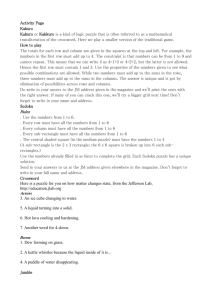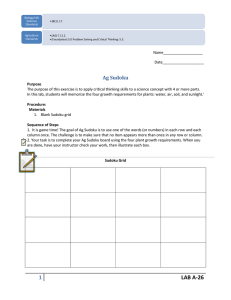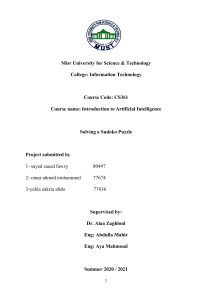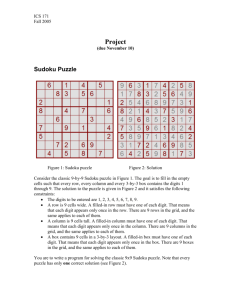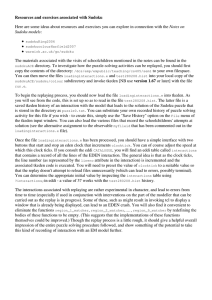Sudoku Assignment SA405, Fall 2015 Instructor: Phillips
advertisement
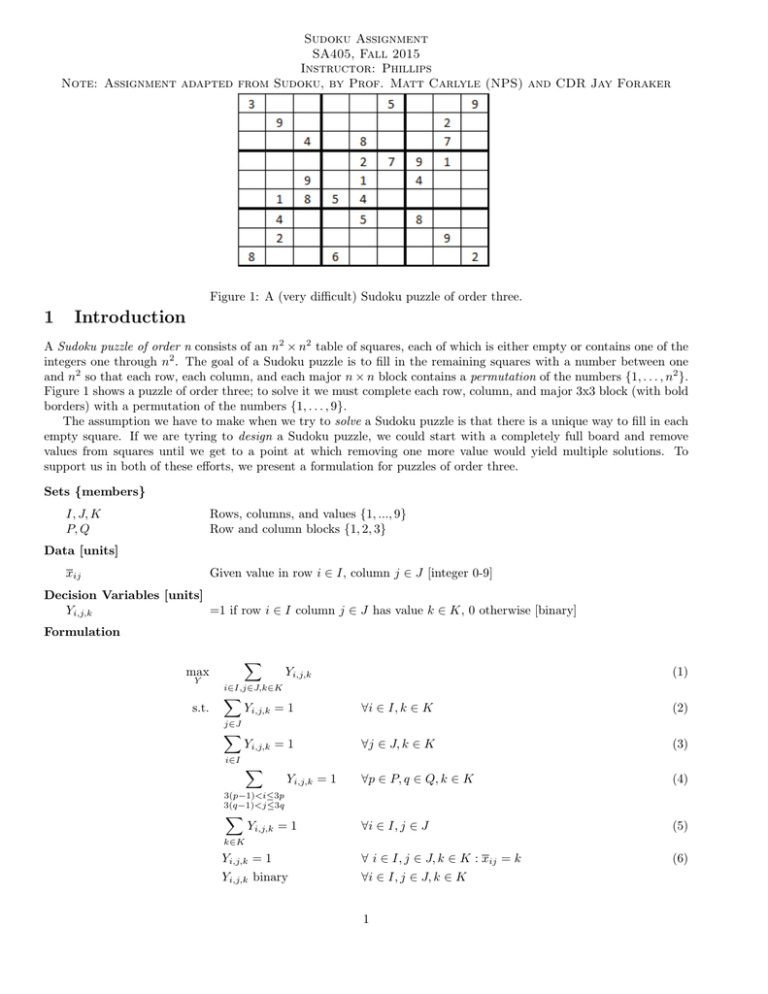
Sudoku Assignment
SA405, Fall 2015
Instructor: Phillips
Note: Assignment adapted from Sudoku, by Prof. Matt Carlyle (NPS) and CDR Jay Foraker
Figure 1: A (very difficult) Sudoku puzzle of order three.
1
Introduction
A Sudoku puzzle of order n consists of an n2 × n2 table of squares, each of which is either empty or contains one of the
integers one through n2 . The goal of a Sudoku puzzle is to fill in the remaining squares with a number between one
and n2 so that each row, each column, and each major n × n block contains a permutation of the numbers {1, . . . , n2 }.
Figure 1 shows a puzzle of order three; to solve it we must complete each row, column, and major 3x3 block (with bold
borders) with a permutation of the numbers {1, . . . , 9}.
The assumption we have to make when we try to solve a Sudoku puzzle is that there is a unique way to fill in each
empty square. If we are tyring to design a Sudoku puzzle, we could start with a completely full board and remove
values from squares until we get to a point at which removing one more value would yield multiple solutions. To
support us in both of these efforts, we present a formulation for puzzles of order three.
Sets {members}
Rows, columns, and values {1, ..., 9}
Row and column blocks {1, 2, 3}
I, J, K
P, Q
Data [units]
Given value in row i ∈ I, column j ∈ J [integer 0-9]
xij
Decision Variables [units]
Yi,j,k
=1 if row i ∈ I column j ∈ J has value k ∈ K, 0 otherwise [binary]
Formulation
X
max
Y
s.t.
Yi,j,k
(1)
i∈I,j∈J,k∈K
X
Yi,j,k = 1
∀i ∈ I, k ∈ K
(2)
Yi,j,k = 1
∀j ∈ J, k ∈ K
(3)
X
∀p ∈ P, q ∈ Q, k ∈ K
(4)
∀i ∈ I, j ∈ J
(5)
Yi,j,k = 1
∀ i ∈ I, j ∈ J, k ∈ K : xij = k
(6)
Yi,j,k binary
∀i ∈ I, j ∈ J, k ∈ K
j∈J
X
i∈I
Yi,j,k = 1
3(p−1)<i≤3p
3(q−1)<j≤3q
X
Yi,j,k = 1
k∈K
1
Discussion
Objective (1) is aribitrary, since we are assuming the solution is unique. Constraints (2) ensure that each row i uses
value k exactly once, while Constraints (3) ensure the same for each column j. Constraints (4) ensure that each major
block uses value k exactly once. Constraints (5) guarantee that each square has exactly one value, and Constraints (6)
fix the squares for which values were already provided.
2
Homework
Submit your model file, data file, and Excel file via Blackboard by 2200 on 27 October 2014.
1. Implement this formulation in GUSEK, and use GLPK to solve the puzzle in Figure 1.
2. Implement an interface in Excel/VBA: give a 9x9 grid, and, with one button push, create a GUSEK data file
and run GUSEK, and then with a second button push read in the solution.
Parts 3 and 4 below are OPTIONAL. To get the BONUS: Submit your modified model file, data
file, and Excel file via Blackboard by 2200 on 27 October 2014.
3. Modify the formulation and GUSEK to determine whether the solution you find is unique. (Hint: modify your
objective function to try to change as many cells as possible from the previous solution. This will require some
extra parameters.)
4. How many filled-in squares can you remove from Figure 1 and keep a unique solution? This can be done with a
macro in VBA (or “by hand”), using parts 2 and 3 above.
2
